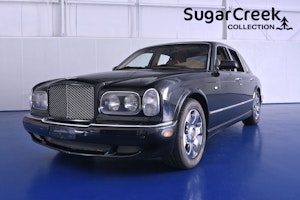Media | Articles
11 rather humorous British car names
When it comes to humorous car names, no automaker is an island. History is filled with head-scratching model designations that never should have seen the light of day, and few in the industry have avoided embarrassment at least a time or two. Americans, for instance, are responsible for a marketing hot potato called the Probe. When deciding upon a name for the car, we’re guessing that Ford execs had space exploration in mind. But in most people’s imagination, a Probe is used by a physician, not an astronaut. How uncomfortable are those seats, anyway?
With that humiliation in mind, we’re shining the spotlight on our friends from across the pond. While we realize that a number of Japanese automakers have factories there-and technically we could include a handful of hilarious names that simply got lost in translation-that’s just too easy.
So we put our heads together and came up these 11 quite chuckle-worthy UK car names. We know, we know-different cultures, different meanings. But admitting that Americans have also blown it many times when it comes to car names, let’s have a laugh together, shall we?
Hillman Minx and Super Minx
Marketplace
Buy and sell classics with confidence
20180309205245)
How did this name last for so long? The Hillman Minx, a mid-sized family car, was produced from 1932 to 1970, and the even bigger Super Minx was offered from 1961 to ’67. The word minx—a dated term for a flirtatious female—has been around for hundreds of years, so it’s not like it evolved into an inappropriate idiom after the birth of the car. It was to begin with. And while minx isn’t as outrageous as a lot of other four-letter words we can think of—and it admittedly makes for great comedy (watch this clip of Hugh Grant talking to a portrait of Margaret Thatcher in Love Actually)—it (rightfully) wouldn’t fly as a car name today.
Austin Hereford
20180309205053)
The 1950–54 Austin A70 Hereford is a corny joke begging for a punchline. Or lots of them. The Hereford is a bit wider and longer that the car it replaced, the Hampshire. Well, of course it is; it’s a cow. (Rim shot.) With a top speed of 80.5 mph, the Hereford could really moooooooove. (Rim shot.) OK, we’re done now.
Wolseley Mudlark
20180309210137)
No, this isn’t a professor at Hogwarts. In an effort to replace the American Jeep with its own British-built, lightweight military vehicle, the Nuffield Organisation introduced the Wolseley Mudlark in July 1950. The Mudlark, an advanced design that evolved from three Nuffield Gutty prototypes (we’re not making this up), was the forerunner of the Austin Champ. If the name Wolseley Mudlark isn’t amusing enough, Mudlarks appeared in a 1957 science fiction movie called Quartermass. They were driven by zombies, naturally.
Vauxhall Adam
20180309205623)
Currently available and of particular interest to guys named Adam, the Vauxhall Adam honors Opel’s founder, Adam Opel, who died in 1895, more than 120 years ago. Hmmm. It makes a lot more sense when you consider that in Europe it’s called the Opel Adam – Vauxhall cars today are just rebadged Opels. No, actually it doesn’t. It’s just weird.
BMC Mini Moke
20180309205024)
An open-air vehicle similar to a Jeep, British Motor Corporation’s 1964–68 Mini Moke was also known as the Austin Mini Moke, Morris Mini Moke, and Leyland Moke. The name is derived from combining “Mini,” the car with which it shares lots of parts, and “moke,” an age-old term for a horse or donkey, “typically of inferior quality.” Oops. Should have looked that one up first.
Austin A40 Farina
20180309205039)
The small family car was around for nearly 10 years (1958–61 and 1962–67), about the same length of time that child actor Allen Clayton Hoskins played the character Farina in Our Gang shorts from 1922–31. There’s no truth to the rumor that Austin also considered building an Alfalfa.
Austin Maxi
20180309205155)
Wait a tick. The maker of the Austin Mini also offered a Maxi (1969–81)? Ahhh, the symmetry. Except that Austin’s idea of “Maxi” was actually a medium-sized car. Now that’s funny.
Humber Super Snipe
20180309205321)
There’s the Humber Snipe, and then there’s the Humber Super Snipe. In production from 1938 to 1967, the Super Snipe saloon (or sedan in the U.S.) was originally marketed to British professionals and government officials. It likely got its model designation from the camouflaged marsh bird of the same name, but these days, when you hear about someone “sniping,” they’re either taking a photo of someone without their permission or placing a bid at the very last second in order to win an auction. Both of those Super Snipes super suck.
Hillman Imp
20180309205225)
Hillman strikes again. Looking for a fitting name for its small, rear-engine, rear-wheel drive economy car, built 1963–76, Hillman chose… Imp. That’s “a small, mischievous devil or sprite.” When you want to evoke feelings of trustworthiness and reliability, you might want to steer clear of comparisons to Satan. Naming a car Imp is as ridiculous as calling a car Gremlin. Oh, wait.
Riley Elf
20180309205337)
This name is a slight—or should we say small?—improvement over Imp, since people actually love elves, especially at Christmastime. Then again, maybe the name is a subtle warning that drivers taller than five feet might want to look elsewhere for a comfortable ride.
Singer Chamois
20180309205353)
Sibling to the Imp (now there’s something for the resumé), the 1964–70 Singer Chamois was a sportier version of the mainstream Hillman. While it had fancy walnut veneer on the inside and additional chrome on the outside, we’re used to wiping our cars with a chamois, not driving one to the grocery store.









